Chris's camera pages
A brief history of the early Braun Paxettes
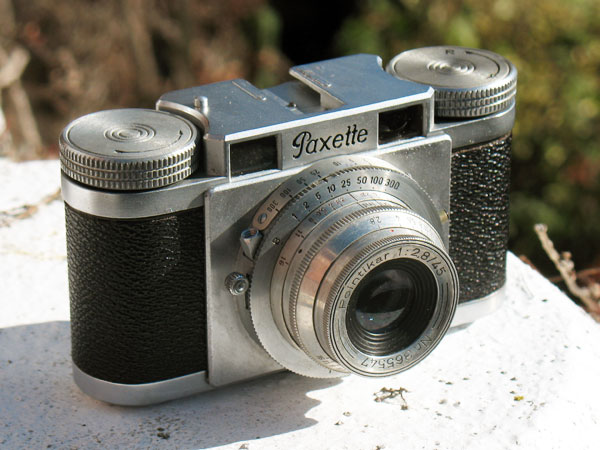
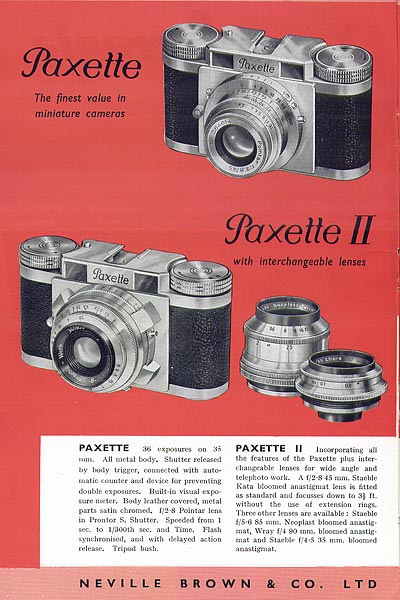
By 1954 both models were being advertised in the British Journal Photographic Almanac. The cameras bear no identifying model number, but they can be easily distinguished from each other because the Paxette has a fixed lens, while the lens is interchangeable on the Paxette II.
This first generation have flat top covers with the accessory shoe being integral to the casting. Both cameras have a knob to advance the film, both cameras are fitted with an extinction exposure meter, and both cameras have a flash-synchronised Prontor S shutter with speeds from 1 to 1/300 second.
The instruction book makes mention of a Paxette fitted with an f/3.5 lens in a four-speed Vario shutter. I'd never heard of this model, but they do really exist and I finally found a picture of one on the internet to prove it. Unfortunately the picture has now disappeared. Marek has now come to the rescue with this photo of one that he owns.
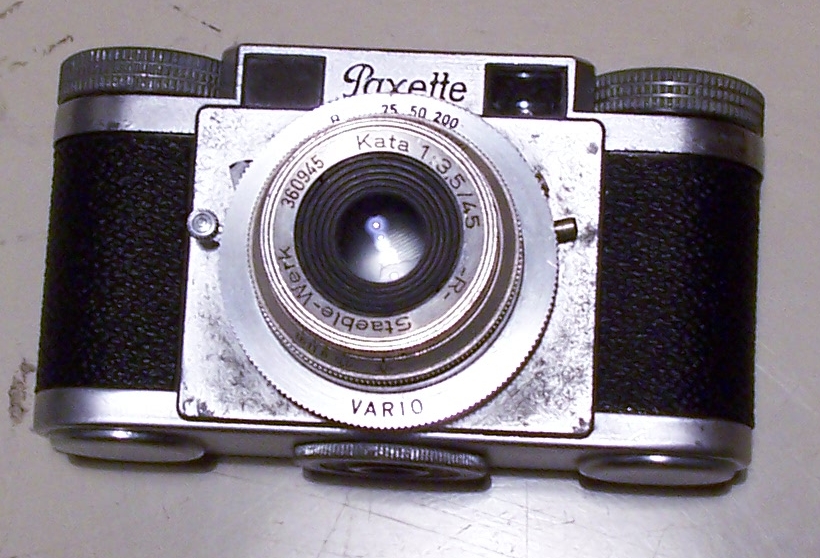
The example I have has the pressure plate fixed to the camera back, and lacks any serial number on the body.
Features added in later Paxette models included a rapid-wind film advance lever to replace the advance knob, an uncoupled rangefinder in place of the extinction meter, and a change in the shape of the top cover casting.
The top cover changed shape twice, one version is flat like the original, except the shoe is no longer integral, but is made of pressed steel. The top of the shoe now sits a millimetre or so above the casting. Another change saw the top cover casting change to one with a raised centre section where the accessory shoe is fitted.
The change from the integral accessory shoe may have been prompted by concerns around possible damage to the casting if something oversize was forced into the shoe. A separate shoe of pressed metal in the traditional form has considerable 'give', and can take a great deal of abuse before fracturing.
The change to the top casting with a raised centre section may have been driven by a need for more room 'under the hood' to fit in a rangefinder.
The change to a rapid-wind lever is a different matter, this was probably not something changed to overcome an engineering limitation, but was done simply to add value to the product by making it more convenient for the consumer to use.
Now some pure guess-work, I'm going to assume that the rapid-wind lever was fitted to all models at the same time.
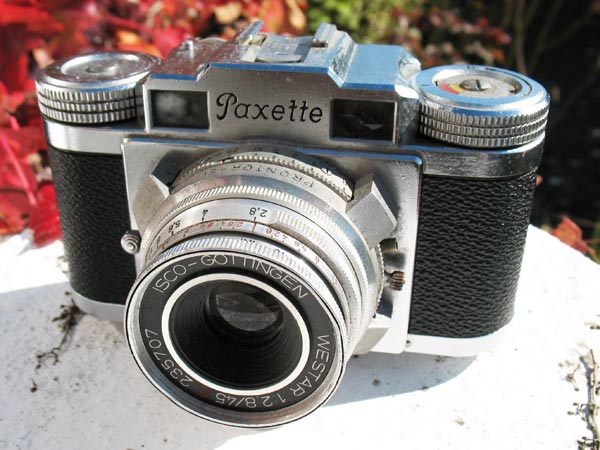
You can see in the picture that the style of both the film advance and rewind knobs has changed from the earlier cameras, and the rewind knob now has a film reminder dial in the centre.
The Isco Westar lens on this camera lacks the cam to couple to a rangefinder, and so would have not been suitable for a later Super Paxette, but that presents no problem with a Paxette II or IIM.
This example has the pressure plate fixed to the body hinged at the top, and lacks a serial number on the body.
Another IIM I have, but this time with an advance lever, also has the pressure plate fixed to the body at the top, and also lacks a serial number.
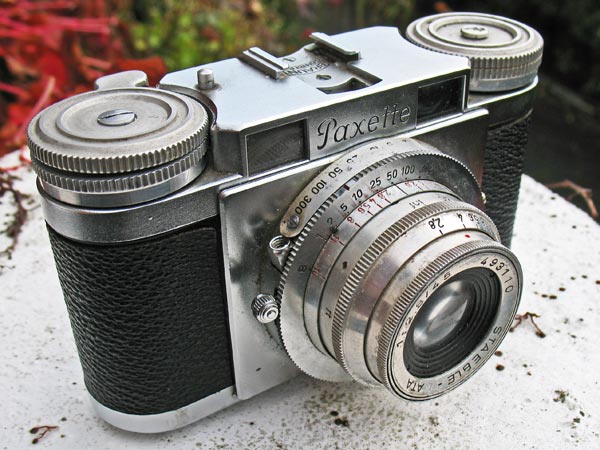
This camera also has the pressure plate fixed to the body at the top, and lacks a serial number.
These observations are supported by the illustrations in the 1955 Focal Press 'Paxette Guide', which identifies the following models of Paxette.
The Paxette I, no longer just 'Paxette' you'll notice, is shown as having a flat top cover casting, with separate accessory shoe, and now has a rapid-wind film advance lever. The shutter fitted is now a Prontor SVS.
The Paxette IM, this is like the Paxette I, but in addition the rapid-wind film advance lever, and Prontor SVS shutter, it has the new top cover casting with raised centre section, and the extinction meter has been replaced by an uncoupled rangefinder.
The Paxette II is described as having all the features of the Paxette I, but with an interchangeable lens, it not entirely clear from the description which top cover it has, although the illustration used shows a Paxette with raised top, without a rangefinder, and I would take this to mean that the II was by now fitted with new top cover.
The Paxette IIM, which is described as having the same features as the Paxette IM, but with an interchangeable lens.
Mention is made in the guide that earlier Paxettes used a Prontor S, or SV shutter, so more possible variations may exist.
By 1956 Super Paxette models had joined the others, they differed from the Paxettes in having a coupled rangefinder. In the September 1956 H.E Perry catalogue, there is listed a Super Paxette Ib, with fixed Staeble Kata 45mm f/2.8 lens, Pronto shutter and coupled rangefinder, and a Super Paxette I with the same fixed Staeble Kata lens, and features, but with a Prontor SVS shutter. The Super Paxette II is also listed, same features as the Super Paxette I, except it has an interchangeable lens.
At this time a number of different standard lenses were available for the Super Paxette II, as listed below, least expensive first.
- Staeble Kata 45mm f/2.8
- Steinheil Cassarit 45mm f/2.8
- Schneider Xenar 50mm f/2.8
- Staeble Luxon 50mm f/2.0
- Steinheil Quinon 50mm f/2.0
- Zeiss Tessar 50mm f/2.8
- Staeble Choro 38mm f/3.8
- Isco Westron 35mm f/3.5
- Staeble Telexon 85mm f/5.6
- Steinheil Quinar 85mm f/3.5
- Roeschlein Telenar 90mm f/3.8
- Enna-Werk Ennaston 135mm f/3.5
- Roeschlein Telenar 135mm f/3.5
The Super Paxettes have had their first mention in the guide now too, the Super Paxette I is described as being similar to a Paxette IM, but with a coupled rangefinder. The Super Paxette II is described as being similar to the Paxette IIM, but with a coupled rangefinder.
Somewhere along the line, Braun started marking the camera bodies with a serial number. All the later cameras that I have in my collection have the pressure plate fixed to the body, but hinged at the bottom rather than the top, with a serial number engraved or stamped into the body just below the film gate. They all had a lever to advance the film, instead of a knob, and they all had the cast top housing with a raised central section.
Back to Camera List